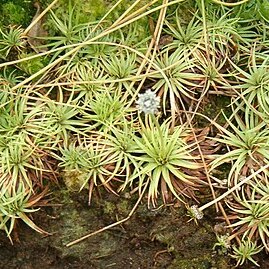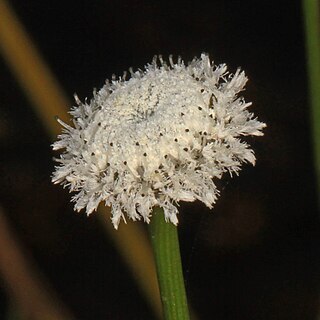Herbs, perennial, 20--70 cm. Leaves linear-attenuate, 5--30 cm, apex subulate. Inflorescences: scape sheaths mostly longer than principal leaves, loose; scapes linear, 1--3 mm wide, multiribbed (ribs lacunar); heads chalk white except for dark gray or near black exserted tips of receptacular bracts, anthers, hemispheric to subglobose, 10--20 mm wide, soft, much flattened when pressed; receptacle pilose; involucral bracts frequently squarrose, later obscured by mature bracteoles and flowers, gray, broadly ovate to oblong or elliptic, 2--3 mm, margins entire, apex rounded or obtuse, glabrous; inner bracts, receptacular bracteoles dark gray, spatulate-linear to oblong, 2--3 mm, margins entire, apex acute with white, club-shaped hairs. Staminate flowers: sepals 2, pale or with dark apex, linear or linear-spatulate, 2--4 mm, apex acute to blunt with mealy white, club-shaped hairs; androphore broadly club-shaped; petals 2, pale, oblong, conspicuously unequal, larger lobe apically fringed with pale, club-shaped hairs, smaller lobe glabrous or with a few hairs at apex; stamens 3--4(--6); anthers black. Pistillate flowers: sepals 2, dark at apex, oblong-spatulate, 2.5--3 mm, abaxially with mealy white, club-shaped hairs, adaxially with translucent hairs; petals 2, pale, oblong-spatulate, apex acute, abaxially with mealy white, club-shaped hairs, adaxially with translucent hairs; pistil 2-carpellate. Seeds dark lustrous brown, broadly ovoid to near round but asymmetric, 0.5 mm, mostly minutely spiny-papillate.
More
Much like no. 3 [Eriocaulon decangulare L]; foliage softer and more spongy; scape-sheath usually surpassing the lvs; heads softer, unisexual or nearly so, the plants subdioecious; outer invol bracts grayish-translucent, 2–3 mm, broadly ovate to oblong or elliptic, blunt, often squarrose; receptacle less copiously hairy, its dark-tipped bracts blunt or subacute, not protruding. Wet places or shallow water on the coastal plain from N.J. to Fla. and Tex. and in the mts. of N.C. May–July.


